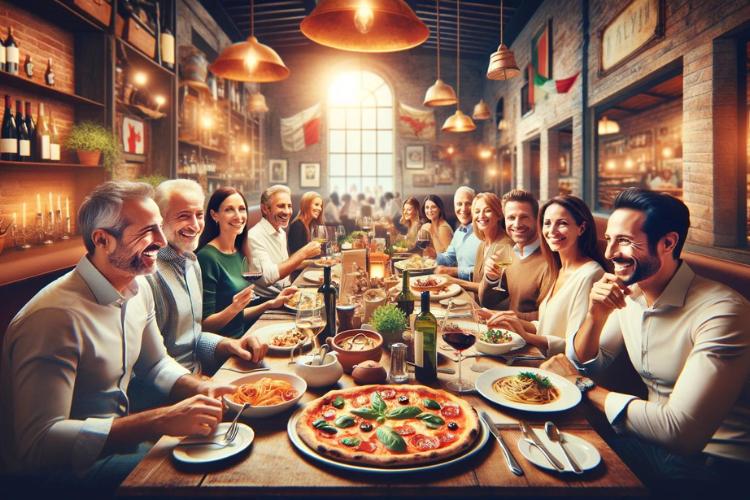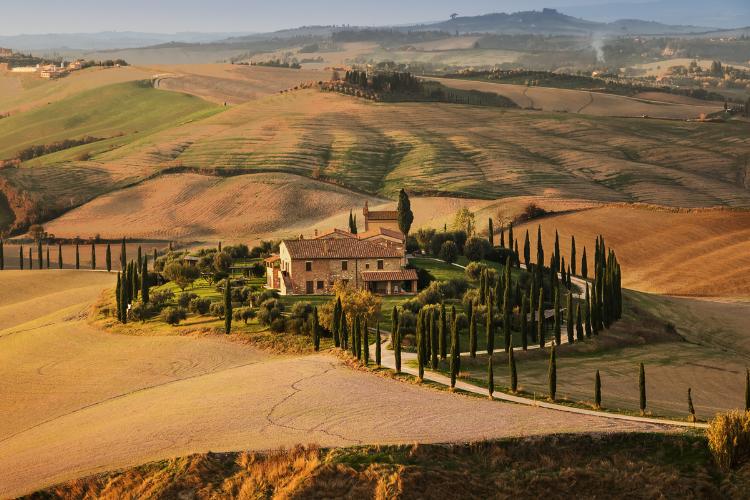10 Different Types of Italian Restaurants Explained
Exploring the different types of Italian restaurants reveals the rich diversity of Italy’s culinary scene, from the cozy trattoria to the sophisticated ristorante.
Each establishment offers a unique window into the regional flavors and traditions that define Italian cuisine, catering to a range of dining experiences and expectations.
Types of Italian Restaurants
Italian restaurants can be confusing, with various options catering to different dining preferences and experiences.
Whether it’s the casual charm of an osteria, the ristorante’s gourmet allure, or the pizzeria’s rustic simplicity, these Italian eateries embody the country’s celebrated food culture.
Each establishment reflects the meticulous artistry of the best Italian chefs, who are renowned for their commitment to fresh ingredients and time-honored cooking techniques. This ensures an authentic and unforgettable dining experience.
Next, we’ll explore what makes each type of restaurant unique, from their atmosphere to their service and dishes.
1. Ristorante: Elegant Dining and Wine Selection

A Ristorante represents the pinnacle of Italian dining, embodying a blend of sophistication and a welcoming atmosphere that caters to a discerning crowd.
This type of establishment spans the spectrum from cozy and intimate to the epitome of fine dining, with the common denominator being a higher degree of formality and, typically, a higher price point.
Upon arrival, guests are greeted by a hostess and can expect comprehensive table service, including being handed a menu that boasts a broad selection of dishes and culinary styles.
Dining here is an experience that often includes multi-course meals and the expertise of an in-house sommelier, who is available to recommend wine pairings that complement your chosen dishes.
The ambiance and the expectation of casual-chic attire underscore the ristorante’s dedication to a dining etiquette that enhances the overall experience.
Travelling to the Amalfi Coast? Don’t miss our review of the best restaurants in Positano.
2. Trattoria: Authentic Italian Cooking in a Family Setting

A Trattoria offers a delightful middle ground in Italian dining, nestled between a ristorante’s formality and an osteria’s casualness. Often family-run, these establishments trace their name back to the French “traiteur,” signifying a host.
Italian trattorias are cherished for their blend of affordability and warmth, making them a favored spot among both travelers and locals. Here, the emphasis is on home-cooked meals that bring local cherished recipes to the forefront, served in an inviting and unpretentious setting.

The ambiance is characterized by a laid-back feel, where high-quality, locally sourced dishes and a comprehensive selection of Italian wines are enjoyed amidst wooden furnishings and family photographs.
Trattoria is the place to go for those looking to enjoy seasonal Italian food, engage in lively conversations over simple yet delicious wine, and relax in a homely atmosphere that celebrates the joy of shared meals.
3. Osteria: Casual Wine Bars with Simple Meals

An Osteria presents a charming and informal dining experience that captures the essence of local Italian culture, serving as a cozy wine bar where the focus is on light, appetizing regional specialties designed to accompany your choice of drink, usually local wines.
Osteria is the perfect type of Italian restaurant for locals and visitors alike seeking to indulge in an evening aperitivo accompanied by simple snacks, setting the stage for a night out or a precursor to dinner elsewhere.
The line between an Italian osteria and a trattoria can often blur, with both offering less formal settings than a ristorante, yet each maintains a unique charm that contributes to Italy’s rich culinary tapestry.
Suggested Read: 100 Most Interesting Italian Food Facts You’ll Love
4. Pizzeria: Iconic Italian Pizzas and Casual Atmosphere

The Italian pizzeria stands out as perhaps the most universally recognized type of eatery on this list, dedicated to crafting and serving pizza.
In Italy, a genuine pizzeria is characterized by its use of a wood-burning oven and the expertise of a “pizzaiolo,” or pizza maker, focusing exclusively on pizza. These establishments can vary widely in ambiance, from casual to more upscale settings.
Although a traditional pizzeria specializes solely in pizza, it’s not uncommon to encounter “Ristorante Pizzeria” venues that offer a broader menu, including a variety of appetizers, main courses, and desserts alongside their pizza selections.
Additionally, for those seeking a quick and convenient option, “pizza al taglio” provides pizza by the slice, typically served wrapped in cardboard or wax paper for easy handling.
Suggested Read: 110 Fun Facts About Pizza: A Slice of Global Culture
5. Enoteca: Wine Focused Italian Bar with Light Bites and Tastings

An Enoteca represents the quintessential Italian wine bar, evolving from its historical roots where it primarily sold wine by the glass or bottle for home consumption, to embracing the role of a full-service dining experience while still emphasizing its expansive wine selection.
Today, while traditional enotecas focusing solely on wine sales exist, many have expanded their offerings to include a menu of Italian appetizers, marrying the concept with that of a full dining establishment yet distinguishing themselves with a specialized focus on wine.
This focus sets the enoteca apart from an osteria, with the former placing wine at the forefront of the experience.
6. Tavola Calda: Quick, Ready-to-Eat Italian Dishes

Tavola Calda, Italy’s upscale take on fast food, epitomizes convenience without compromising on quality.
Translated as “hot table,” this type of Italian restaurant provides a wide array of ready-to-eat dishes, offering everything from crispy arancini to warm slices of pizza al taglio.
Additionally, operating with a straightforward, no-frills approach, a tavola calda serves prepared foods made daily, ranging from pasta and risotto to meats and vegetables.
While primarily focused on take-home food, most tavola caldas also feature a few small tables for those who prefer to sit and enjoy their meal on the premises
7. Agriturismo: Farm-to-Table Meals in Rustic Settings

Agriturismo offers a unique blend of hospitality and gastronomy, embodying the essence of farm-to-table dining amidst Italy’s picturesque countryside. At the heart of agriturismo is the commitment to authentic, locally sourced cuisine, with ingredients often grown or raised directly on the property.
This approach ensures an exceptionally fresh dining experience, allowing guests to savor dishes prepared by locals at prices generally more affordable than those found in traditional hotels with restaurants.
While agriturismo in Italy is technically known for offering accommodation, it’s increasingly sought after for its culinary offerings, becoming a favored destination for Italians and tourists to immerse themselves in the true flavors and tranquility of Italian rural life.
8. Pesceria: Fresh Seafood Markets with Adjacent Eateries

While not a traditional type of Italian restaurant, a Pesceria or fish market plays a crucial role in Italy’s culinary landscape. It is the right place to eat a wide selection of freshly caught fish from the day.
Along its coastlines, Italy is blessed with the Mediterranean, Adriatic, Ligurian, and Ionian Seas It has a rich heritage of exquisite seafood. Within and around these markets, top-rated restaurants often use fresh catches to serve delectable seafood dishes.
9. Rosticceria: Savory Roasts and Meaty Takeaway Delights

A Rosticceria, similar in concept to a Tavola Calda, specializes in offering savory delights for those seeking quick yet delicious meals, focusing on slow-cooked roasts and ready-made options rich in meat, from succulent porchetta to savory rotisserie chicken.
Generally, a Rosticceria is geared more towards take-home options, with it being rare to find facilities offering seating to eat on the premises.
Designed for convenience, a Rosticceria ensures that every meal is expedient and packed with exceptional flavors, perfectly balancing speed and culinary excellence.
Here, the emphasis is on ensuring that even the busiest of patrons can enjoy a meal that satisfies the palate without the need for extensive dining time, making it an ideal choice for on-the-go eating without sacrificing quality.
10. Paninoteca: Sandwich Bars Featuring Italian Panini and More

A Paninoteca is an Italian sandwich bar that elevates the simple pleasure of enjoying a sandwich into a culinary experience.
These charming little shops, scattered throughout the country, specialize in offering a variety of Italian snack foods, primarily panini (remember, “panino” for singular) and tramezzini, along with selections of bread, cold cuts, and cheese.
Paninoteca is a testament to Italy’s rich culinary landscape, offering a casual yet authentic dining option for those wanting to experience a slice of Italian gastronomy without the need for a sit-down meal.
Before You Go…
From finding out about all kinds of Italian restaurants, let’s now dive into understanding “coperto” and its role in your dining adventures in Italy. Read our guide: What is Coperto in Italy? Cover Charge and Tipping Guide.







